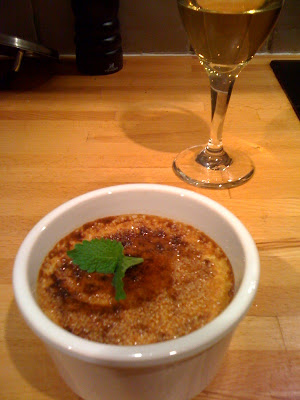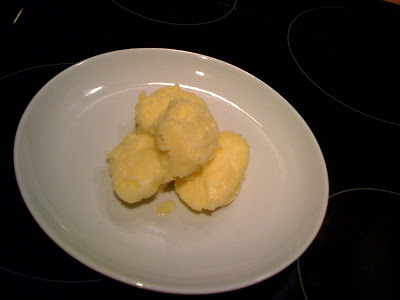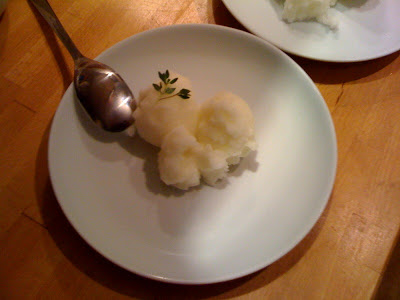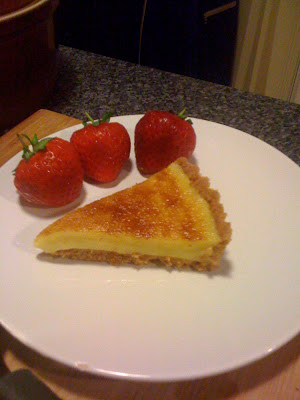Category: Desserts
Kiwifruit Sorbet
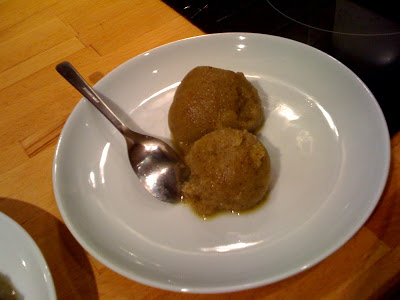
This was a great tasting sorbet. The taste is a bit unusual but very refreshing and interesting. The crushed seeds from the kiwifruits adds an additional texture to the sorbet.
Ingredients for the kiwifruit sorbet:
1 kg of kiwifruits (10 to 15 kiwifruits)
1 leaf of gelatine
150 g caster sugar
330 ml water
1 lemon (optional)
Preparing the kiwifruit sorbet:
Start by preparing the kiwifruits (this will take a bit of time…). The easiest way is to half them, then peel them with a paring knife and then removing the tough end bit and the woody bit in the middle of the fruit. Quarter the halves and put them in a blender.
Meanwhile heat the sugar and the water to create a syrup. When the sugar is completely dissolved in the water take it off the heat. Bloom the leaf of gelatin in a bowl of cold water for 5 minutes then drop it into the syrup and stir until it dissolves. Let the syrup and gelatine mixture cool to room temperature.
Blend the kiwifruits until you end up with a puree. You should have about 500 ml of fruit puree after blending. Add the syrup and blend some more. Add some lemon juice if you think it needs more acidity.
Freeze in ice cream maker according to your ice cream makers instructions (probably around 30-45 minutes).
Pineapple Champagne Sorbet
Lemon Thyme Sorbet
Being a big fan of lemon thyme I wanted to incorporate it into a sorbet.
This is basically the recipe I use for lemon sorbet but with lemon thyme infused into the simple syrup.
The lemon thyme adds an interesting herbal note which works well with the lemon. Use as much lemon thyme as you want, I would suggest a handful or so.
Ingredients for the lemon thyme sorbet:
1 leaf of gelatine
150 ml caster sugar
100 ml water
100 ml freshly squeezed lemon juice (about 3-4 small lemons, I used a little bit more than 100 ml since I don’t like my lemon sorbet too sweet)
100 ml whole milk
Lemon thyme, a handful or so
Preparing the lemon thyme sorbet:
Put the leaf of gelatine in a bowl with cold water and let it soak for 5 minutes. Mix the sugar and water in a medium saucepan and bring it to a boil, when it reaches boiling point turn of the heat. Add the lemon thyme twigs and let them infuse the syrup for 10 minutes or so.
Add the gelatin leaf to the syrup and stir until it’s melted.
Let the mixture cool to room temperature (don’t make it go cold since it will set).
Add the lemon juice and milk and mix properly.
Pass the mixture through a sieve into a clean glass jug, discard the lemon thyme twigs.
Freeze in ice cream maker according to your ice cream makers instructions (probably around 30-45 minutes).
Lemon Sorbet
I got an ice cream maker at Christmas so I have slowly been experimenting with ice creams and sorbets when time permits. My first attempt was a rose-raspberry sorbet. It was alright but not spectacular. I will retry it in the summer as I suspect it could work nicely after a barbeque. My second attempt was lemon sorbet. I was making a pasta sauce (spicy meatballs and tomato) so I thought a lemon sorbet would be a great dessert and tie in nicely with the pasta.
This is my favorite recipe for lemon sorbet, the addition of gelatin makes the sorbet a bit less icy and more smooth. The addition of milk makes it a touch more creamy again and gives it a nice snowy white color. I reckon it makes about 600 ml or so, should be enough for about four people.
Ingredients for the lemon sorbet:
1 leaf of gelatine
150 ml caster sugar
100 ml water
100 ml freshly squeezed lemon juice (about 3-4 small lemons, I used a little bit more than 100 ml since I don’t like my lemon sorbet too sweet)
100 ml whole milk
Preparing the lemon sorbet:
Put the leaf of gelatine in a bowl with cold water and let it soak for 5 minutes. Mix the sugar and water in a medium saucepan and bring it to a boil, when it reaches boiling point turn of the heat.
Add the gelatin leaf to the syrup and stir until it’s melted.
Let the mixture cool to room temperature (don’t make it go cold since it will set).
Add the lemon juice and milk and mix properly.
Freeze in ice cream maker according to your ice cream makers instructions (probably around 30-45 minutes).
Lemon Tart
This is the first dessert recipe I did from the wonderful book “Bouchon” by Thomas Keller. It was not too difficult to do and really delicious. It makes enough lemon tart for about six people.
We had it with some strawberries but something like a vanilla cream would go well with it as well since it’s quite acidic.
Ingredients for the pine nut crust:
285 grams (about 470 ml) pine nuts
80 ml sugar
455 grams (about 710 ml) all-purpose flour
230 grams unsalted butter, at room temperature
1 large egg
1 teaspoon pure vanilla extract
Preparing the pine nut crust:
Place the pine nuts in a food processor and pulse a few times. Add the sugar and flour and continue to pulse until the nuts are finely ground. Transfer the mixture to a large bowl. Add the butter, egg, and vanilla extract and mix to incorporate all the ingredients (the dough can be mixed by hand or in a mixer fitted with the paddle attachment). Divide the dough into three equal parts. Wrap each piece in plastic wrap and refrigerate for at least 10 minutes before using. (The extra dough can be frozen, wrapped well, for up to 1 month.
Ingredients for the lemon tart:
Butter and flour for the tart pan
1/3 recipe pine nut Crust
Lemon sabayon:
2 large eggs, cold
2 large egg yolks, cold
180 ml sugar
120 ml fresh lemon juice
85 grams cold unsalted butter, cut into 6 pieces
Preparing the lemon tart:
For the crust:
Preheat the oven to 170°C. Generously butter and flour a 9-inch fluted tart pan (it should be about one inch deep) with a removable bottom and refrigerate it while the oven preheats. Remove the tart pan from the refrigerator. Use your fingertips to press the chilled pine nut dough evenly over the bottom and up the sides of the pan. Trim off any excess dough (this extra dough can be made into a cookie that you can cook at the same time as the crust). Bake the crust for 10 to 15 minutes, then rotate it and bake for another 10 to 15 minutes, or until it is golden brown. Remove the crust from the oven and let it cool while you make the filling. (There may be some cracks in the crust; they will not affect the finished tart.) For the sabayon:
Bring about 1 1/2 inches of water to a boil in a pot that is slightly smaller than the diameter of the bowl you will be using for the sabayon. Meanwhile, in a large metal bowl, whisk the eggs, yolks, and sugar for about 1 minute, or until the mixture is smooth. Set the bowl over the pot and, using a large whisk, whip the mixture while you turn the bowl (for even heating). After about 2 minutes, when the eggs are foamy and have thickened, add one-third of the lemon juice. Continue to whisk vigorously and, when the mixture thickens again, add another one-third of the lemon juice. Whisk until the mixture thickens again, then add the remaining lemon juice. Continue whisking vigorously, still turning the bowl, until the mixture is thickened and light in color and the whisk leaves a trail in the bottom of the bowl. The total cooking time should be 8 to 10 minutes. Turn off the heat and leave the bowl over the water. Whisk in the butter a piece at a time. The sabayon may loosen slightly, but it will thicken and set as it cools. Pour the warm sabayon into the tart crust and place the pan on a baking sheet. Preheat the broiler. While the sabayon is still warm, place the tart under the broiler. Leaving the door open, brown the top of the sabayon, rotating the tart if necessary for even color; this will take only a few seconds, so do not leave the oven. Remove the tart from the broiler and let it sit for at least 1 hour before serving. Serve at room temperature or cold.
